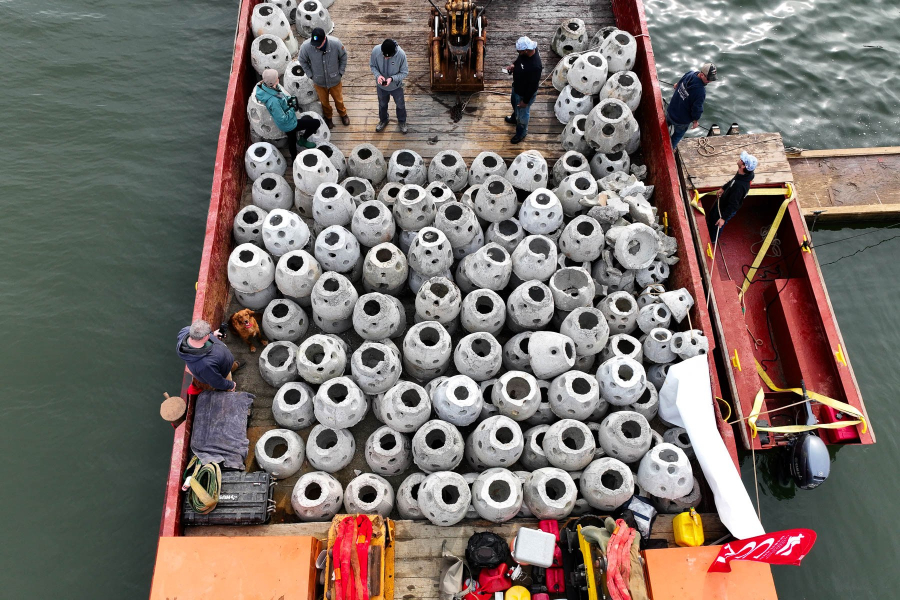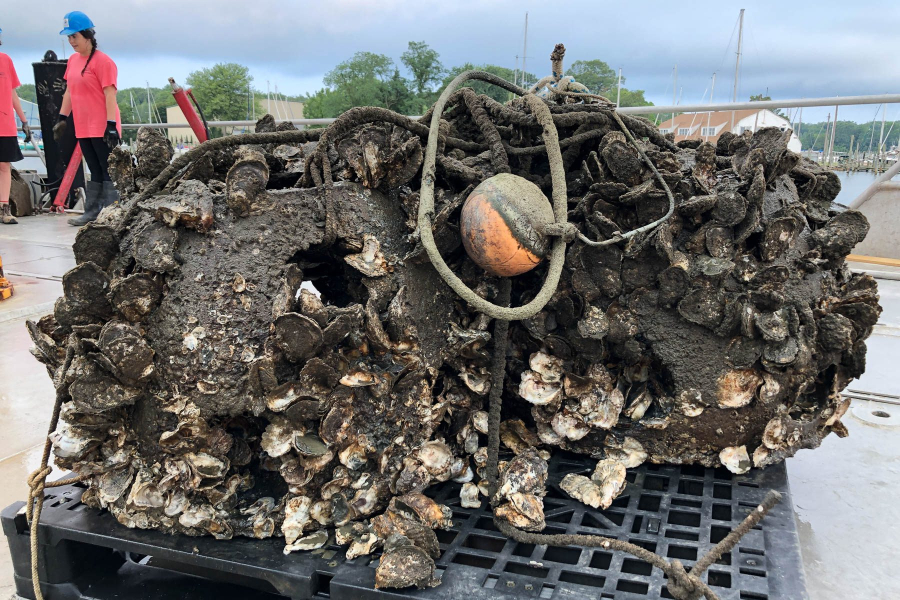Better fishing is the end goal for this oyster habitat program
Coastal Conservation Association Maryland, approaches 10 years of reef ball deployment

For nearly 10 years, the Coastal Conservation Association (CCA) Maryland has been building and deploying hundreds of concrete “reef balls” that settle at the bottom of Chesapeake Bay’s tributaries.
Over time, the reef balls become habitat for oysters, mussels, barnacles and various plant matter that attach themselves to the structure. But while these critters are important, what the nonprofit is really after is blue crabs, striped bass, sturgeon and other big Bay fish that show up to eat everything growing on the artificial reef.
“And our mantra is habitat today, fish tomorrow,” said David Sikorski, executive director of CCA Maryland.
CCA Maryland is a local chapter of the national nonprofit that was founded in 1977. Made up of 19 local chapters, CCA advocates for laws and regulations that benefit recreational and commercial fishing, and coordinates local restoration projects to improve habitat in places like the Chesapeake Bay.
“Ultimately, we were founded to create a voice for recreational anglers,” Sikorski said, who is himself a long time angler of the Chesapeake Bay.
CCA Maryland has a number of programs and advocacy initiatives, but has found large success in their reef ball project Living Reef Action Campaign.
Through this campaign, the nonprofit first organizes reef ball building events with students and community volunteers. Using both locally made reef balls or ones constructed by partners, CCA Maryland will then work with other nonprofits and agencies to deploy them in areas of the Chesapeake Bay. Most often these structures have shells with juvenile oysters (known as spat) already growing on them before going into the water.
The habitat created by these reefs then draws in hungry fish like striped bass, which recreational anglers love to catch.
“From a recreational angling perspective, it's a ‘if you build it, they will come’ approach,” Sikorski said.

Since starting the program in 2015, the nonprofit has worked across the Bay, deploying reef balls in places like Tangier Sound, Magothy River, St. Mary’s River and off the coast of Tilghman Island. The nonprofit will often partner with local organizations and the CCA Virginia chapter. Many of the Living Reef Action Campaign projects are funded through the Maryland Department of Natural Resource and aligned with the agency's own oyster reef initiative.
According to Sikorski, CCA Maryland is also starting to partner more closely with companies, schools and community groups looking to give back. In the Magothy River, the nonprofit helped to deploy dozens of reef balls in honor of a local high school student who lost his life to suicide. Known as “Noah’s Reef”, the reef balls spell out the student’s name at the bottom of the Magothy.
In mid-August, CCA Maryland will be deploying their last reef balls in the St. Mary River Oyster Sanctuary where they have partnered with the Chesapeake Bay Foundation and St. Mary’s River Watershed Association.
“In total, the project is 600 reef balls across, just shy of an acre footprint,” Sikorski said.
For oysters and other wildlife to form their reefs, they need a hard surface to attach to, often referred to as “substrate”. Reef balls can serve as this surface but other organizations and state agencies will use oyster shells, crushed stone and existing oyster reefs in the wild.
According to Sikorski, CCA Maryland uses reef balls because natural forms of substrate like crushed oyster shells or existing reefs are in short supply. While organizations such as the Oyster Recovery Partnership work with restaurants to save and reuse shells, there is still a limited amount of oyster shells and wild reefs available.
“We just don't have enough shell as a substrate in the Chesapeake Bay,” Sikorski said.
The reef balls are typically several feet high and wide, and have different pockets for wildlife to attach to and visit. Sikorski said that the “three dimensionality” of reef falls is important to have in the water, as opposed to substrate laying flat on the bottom.
In some cases, community members have been concerned about the use of reef balls, whether deployed by CCA Maryland or other groups. But Sikorski says that their organization is careful not to place reef balls in places that would be a hazard to boaters and swimmers.
CCA Maryland is far from the only organization working to expand oyster habitat. The Chesapeake Bay Program coordinates a team of nonprofits, state agencies and universities that, over the past 10 years, have established oyster habitat in eleven major Chesapeake Bay tributaries for a total of over 2,000 acres of reef.
The Bay was once filled with tower oyster reefs you could see from above water, but over time, some 90% of the wild oyster population was lost to overharvesting, disease and poor water quality. The reefs that these oysters formed fell as well.
“We're really just replicating some of what we've lost over time with oyster reefs in Chesapeake Bay,” Sikorski said.

Comments
There are no comments.
Thank you!
Your comment has been received. Before it can be published, the comment will be reviewed by our team to ensure it adheres with our rules of engagement.
Back to recent stories